
Pandemic, Weather, and War Are Conspiring To Cripple Car Production for Years to Come
After years of supply chain issues, low dealer inventory is still impacting car sales. We’re ready for auto industry production to return to normal, but a confluence of issues continues to conspire to cripple the automotive supply chain. Here are the weather events, other disaster disasters, and wars that may extend the chip shortage until 2024–or for even longer.
What are automotive semiconductors?
Every new car requires at least a couple dozen microchips, while some models are engineered with over 100 microchips. Semiconductors are the metalloid elements at the heart of every one of those computer chips.

The electrification and automation of the automotive fleet mean that newer models usually require more semiconductors than models which have not been updated for a while. Every year, the auto industry needs even more semiconductors.
Then, the global COVID-19 pandemic caused a series of factory closures. This is because some countries declared quarantines, and some corporations had to quarantine when some workers got sick.
Semiconductor production requires a series of specialized materials and processes. Therefore, it did not take many factory closures for global semiconductor production to slow down considerably. This has proven the greatest bottleneck in the automotive industry. Even as COVID-19 quarantines occur less often, other events conspire to slow down the supply chain.
Weather, war, and disaster are affecting semiconductor production
After the COVID-19 quarantines, the auto industry sought to bring semiconductor production back up to pre-pandemic levels. But recent setbacks to the microchip supply chain have included a snowstorm in Texas, a fire at a Japanese chip factory, and the Russian invasion of Ukraine.

By early 2021, the global semiconductor supply chain was set to make up for lost time. Then disaster struck. The Renesa Electronics Corporation’s Japanese factory, responsible for 30% of the automotive market’s microcontroller units caught fire–according to Reuters. While the company announced its factory was salvageable, it took months to resume production.
Many semiconductors are made in the United States, a sizable portion of those in Texas. But at the same time that the Japanese factory was catching fire, unique weather hit Texas. A series of deadly snowstorms actually slowed microchip production in the Lone Star state.
Finally, the 2021 blockage of the Suez canal held up important components for manufacturing microchips.
By 2022, the microchip supply chain appeared to be in the clear. Then Russia invaded Ukraine. According to Consumer Reports, this war has affected the supply of neon gas, an important element for manufacturing semiconductors. This has led to even more gaps in semiconductor production.
What will it take to increase semiconductor production?
The companies building microchips for cars are ramping up production as quickly as possible. For example, the Taiwan Semiconductor Manufacturing Company (TSMC) and others are opening new factories and beefing up existing ones. But this process will not be complete until 2024.

In the meantime, automakers have had to get creative to continue selling cars. One solution has been to delete features and save on microchips. For example, General Motors did not offer heated seats for several months. Another solution has been to put finite semiconductor supplies towards larger vehicles and luxury vehicles, to guarantee a high profit margin.
Curious how this all affects you? Learn how to buy a car amidst supply-chain woes, or watch CNBC’s deep dive into the global computer chip shortage in the video below:



